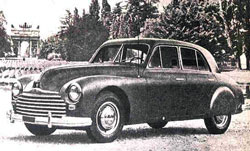Sidebar: Lancia Flavia
The Cemsa Caproni and the
Development of the FWD Flat Four

The front wheel drive flat four concept had a long history. But it was Professor Fessia who
finally made it a success with the Lancia Flavia.
|
The Flavia was the brainchild of Professor Fessia, the genius who - besides having had an important input in the FIAT 500 "Topolino," the FIAT 600 and the Lancia Flaminia - was responsible for the design of the Caproni Cemsa that was first shown in 1947 at the Turin Autosalon.
Fessia had joined the Cemsa Caproni company in 1946. Fessia was also a lecturer at the Politecnico of Milan and also did some consultancy work for Pirelli and Ducati. He started his FIAT career at FIAT-NSU in Heilbronn, West Germany where he designed a 2 cylinder front wheel drive horizontally opposed engine, the F 03, which he then developed into a 2 cylinder water-cooled engine.
After his work for Caproni, he joined Lancia as a young consultant for Vittorio Jano; his first job was redesigning the Appia 1st series. Fessia then went on to become the Head of the Reparto Esperienze (or development) at Lancia.
Fessia's 1100 cc Cemsa (Caproni Elettro Meccanica Societa Anonima) Caproni was an unsuccessful attempt by the famous Italian airplane builder to enter Italy�s post war car market. The Cemsa Caproni was built in the town of Saronno, the place of origin of the famous Lazzaroni Amaretto cookies and the liqueur that goes by the same name.

Even after the Cemsa design was purchased by Minerva in 1953, it remained stillborn. The Hotchkiss-Gregoire of the same era was very similar but far too unattractive.
|
The Cemsa Capronis are in all ways and means to be regarded as the predecessors of the Flavia. The body was designed, and perhaps constructed by Bertone. Only two Cemsa Capronis still exist in Italy; both cars are rumored to be owned by a member of the Caproni family. The whereabouts of other Cemsas (if any at all) is unknown as of today.
But the development of the flat four front wheel drive concept was more international and far earlier than even the 1947 Cemsa, and due in large part to the efforts of a rather eccentric Frenchman by the name of J.A. Gregoire. A fascination with front wheel drive led him to work with Tracta in the 1930s. On his own, he developed a design for a fwd flat twin with an aluminum platform chassis, which was sold to a struggling firm of Amilcar in 1938. Known as the Amilcar Compound, it never saw production. War intervened, and shortly afterward Gregoire penned a 2 liter water cooled flat four fwd car which he sold to Hotchkiss, another ailing French firm. Hotchkess produced this car, the Hotchkiss-Gregoire, in limited numbers. His aluminum chassis flat twin concept was in taken up by Panhard and served as the basis for the Dyna Panhard. In England, the flat four fwd concept was served up by the Jowett Jupiter and Javelin, very advance designs for the early 1950s.
Fessia�s Cemsa appeared again at the 1949 Turin show, but the firm did not put it into production, despite the widespread acclaim. The Belgian firm of Minerva then bought the design in 1953, but again, the car failed to see the light of day.
It would not be until that day in 1960 when the Flavia was introduced, that the fwd flat four would once again make news. This time it would be a resounding success, followed up by the Alfasud and today�s Subaru.



